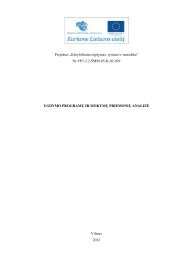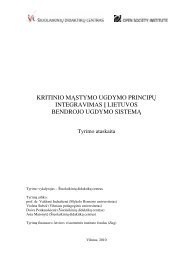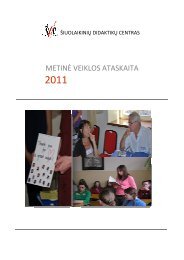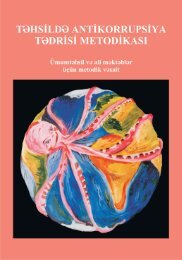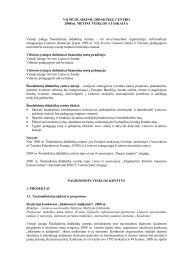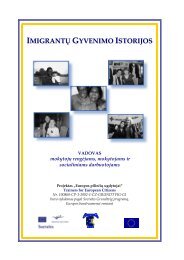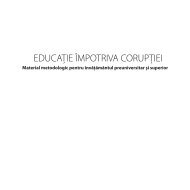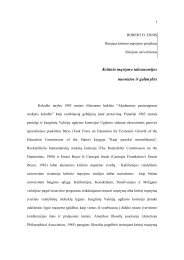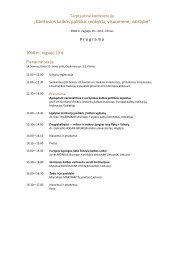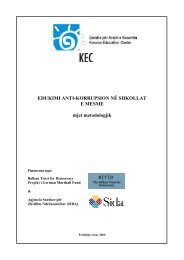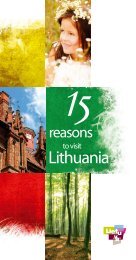Study visit group report
Study visit group report
Study visit group report
Create successful ePaper yourself
Turn your PDF publications into a flip-book with our unique Google optimized e-Paper software.
<strong>Study</strong> <strong>visit</strong> <strong>group</strong> <strong>report</strong><br />
Group No<br />
Title of the <strong>visit</strong> CRED’o: Creative Education – Successful Generation<br />
Topic Creativity<br />
City, country Vilnius, Lithuania<br />
Type of <strong>visit</strong> <strong>Study</strong> <strong>visit</strong><br />
Dates of <strong>visit</strong> 4-8 October 2010<br />
Group <strong>report</strong>er Louise Dollings and Chris Batstone<br />
Dear participants,<br />
The purpose of a study <strong>visit</strong> is to generate an exchange of experience and good<br />
practice between the country you <strong>visit</strong> and the countries you all come from. Thus,<br />
participating in a study <strong>visit</strong> can be an exciting experience and an important<br />
learning tool for you.<br />
During the <strong>visit</strong> you are invited to prepare a <strong>group</strong> <strong>report</strong> summarising your<br />
discussions and learning. This will help Cedefop disseminate what you have learnt<br />
to others, who share your interest but did not participate in this particular study<br />
<strong>visit</strong>.<br />
On the first day of the <strong>visit</strong>, you are to select a <strong>report</strong>er who will be responsible for<br />
preparing the final <strong>report</strong> and submitting it to Cedefop. Everybody should<br />
contribute to the <strong>report</strong> by sharing their views, knowledge, and practices in their<br />
respective countries. Please start working on the <strong>report</strong> from the first day of the<br />
<strong>visit</strong>.<br />
You will, of course, be taking your own notes during presentations and field <strong>visit</strong>s;<br />
but the <strong>group</strong> <strong>report</strong> should highlight the result of the <strong>group</strong>’s reflections on what<br />
was seen and learnt during the entire <strong>visit</strong> and the different perspectives brought<br />
by the different countries and participants. The <strong>report</strong> should NOT read as a travel<br />
diary, describing every day and every session or <strong>visit</strong>.<br />
Cedefop will publish extracts of your <strong>report</strong>s on its website and make them<br />
available to experts in education and vocational training. When writing the <strong>report</strong>,<br />
please keep this readership in mind: make your <strong>report</strong> clear, interesting, and<br />
detailed enough to be useful to colleagues throughout Europe.<br />
By attaching any photos to the <strong>report</strong>, you agree to Cedefop’s right to use them in<br />
its publications on study <strong>visit</strong>s and on its website.<br />
Please prepare the <strong>report</strong> in the working language of the <strong>group</strong>.<br />
Please do not include the programme or list of participants.<br />
The <strong>report</strong>er should submit the <strong>report</strong> to Cedefop<br />
(study<strong>visit</strong>s@cedefop.europa.eu) within ONE month of the <strong>visit</strong>.<br />
1
I FINDINGS<br />
This section summarises the findings of the <strong>group</strong> while <strong>visit</strong>ing host<br />
institutions, discussing issues with the hosts and within the <strong>group</strong>. You will<br />
be reflecting on what you learnt every day. But to put them together and<br />
give an overall picture, you need to devote a special session to prepare the<br />
final <strong>report</strong> on the last day of the <strong>visit</strong>.<br />
In this section, it is important that you describe not only things you<br />
learnt about the host country but also what you learnt about the<br />
countries represented by <strong>group</strong> members.<br />
1. One of the objectives of the study <strong>visit</strong>s programme is to exchange<br />
examples of good practice among hosts and participants. Cedefop will<br />
select well-described projects/programmes/initiatives and disseminate<br />
them to former participants and a wider public, including potential<br />
partners for future projects. Therefore it is important that you<br />
identify and describe all aspects that, in your view, make these<br />
projects/programmes/initiatives successful and worth exploring.<br />
2
Describe each of the good practices you learnt about during the <strong>visit</strong> (both from the hosts and from one another) indicating the<br />
following:<br />
title of the<br />
project/programme<br />
/initiative<br />
Vyturys Primary<br />
School<br />
Vilnius Design<br />
College<br />
Kindergarten<br />
Saules Gojus<br />
country name of the institution<br />
that implements it (if<br />
possible, provide a<br />
website)<br />
Vilnius,<br />
Lithuania<br />
Vilnius,<br />
Lithuania<br />
Vilnius,<br />
Lithuania<br />
Vyturys Primary School<br />
www.vyturio.vilnius.lm.lt<br />
Vilnius Design College<br />
www.dizainokolegija.lt<br />
Kindergarten Saules<br />
gojus<br />
www.kindergarten.lt<br />
contact person (if<br />
possible) who<br />
presented the<br />
programme to the<br />
<strong>group</strong><br />
Ausra Drumstiene,<br />
Headmistress<br />
Giedre<br />
Fledžinskiene,<br />
Director<br />
Laima Sirutiene,<br />
Headmistress<br />
* You can describe as many good practices as you find necessary. You can add rows to the table.<br />
whom the project/<br />
programme/ initiative<br />
addresses<br />
Primary school<br />
children<br />
Higher education<br />
students<br />
what features of the<br />
project/programme/initiative make it an<br />
example of good practice<br />
Creative and cross curricular<br />
approach to teaching.<br />
Creative approach to learning and<br />
to teaching children how to be<br />
creative!<br />
Children 2 – 6 Individual approach to children’s<br />
needs, bilingual foreign language<br />
learning and entirely flexible<br />
approach to teaching methods and<br />
content.<br />
3
2. The study <strong>visit</strong>s programme aims to promote and support policy<br />
development and cooperation in lifelong learning. That is why it is<br />
important to know what you learnt about such policies and their<br />
implementation during your <strong>visit</strong>. You are invited to describe your findings<br />
concerning the following:<br />
2.1 APPROACHES TAKEN BY PARTICIPATING COUNTRIES (BOTH HOST AND<br />
PARTICIPANTS’) REGARDING THE THEME OF THE VISIT. ARE THERE ANY SIMILAR<br />
APPROACHES/MEASURES IN PARTICIPATING COUNTRIES? WHAT ASPECTS ARE<br />
SIMILAR AND WHY? WHAT ASPECTS ARE DIFFERENT AND WHY?<br />
• Similar issues being faced by participants’ and host countries with<br />
regards to education, e.g. changes to education policy as a result of<br />
changes in government, the need to enthuse and engage pupils to raise<br />
standards.<br />
• Similar approaches/measures to developing creativity used by host and<br />
participants’ countries, e.g. cross curricular teaching, focus on art,<br />
design, dance and music, etc.<br />
• Different definitions of “creativity” from host and participants’<br />
countries. These were discussed at length during and after <strong>visit</strong>s (and<br />
during leisure times!). It seems easier to discuss what creativity is NOT<br />
rather than what it is. Creativity was often seen as shorthand for visual<br />
arts and performing arts practice in the settings/schools <strong>visit</strong>ed.<br />
• Host country has a much more autonomous approach than many others-<br />
especially the UK. Lithuanian schools are more independent and key<br />
decisions rest with the principal. There is no regime of inspection by the<br />
Ministry of Education - it instead offers support and guidance and is<br />
moving towards more freedom for schools to innovate/be creative.<br />
• The host country’s educational structure and approach appears to create<br />
better starting conditions to allow creative approaches to be developed.<br />
Many participants also commented that behaviour in schools is generally<br />
very good, and teachers spend less time in classroom management/<br />
behaviour management than in other settings (Netherlands, Spain and<br />
France in particular).<br />
2.2 CHALLENGES FACED BY PARTICIPATING COUNTRIES (INCLUDING HOST) IN THEIR<br />
EFFORTS TO IMPLEMENT POLICIES RELATED TO THE THEME OF THE VISIT. WHAT<br />
ARE THE CHALLENGES? ARE THEY COMMON CHALLENGES? IF SO, WHY? IF NOT,<br />
WHY NOT?<br />
• Class size was discussed and its impact on planning, teaching and<br />
learning. The host country had very small class sizes in comparison to UK,<br />
France and Spain in particular. Behaviour of pupils did not appear to be<br />
significant issue for the host country, whilst this was seen as a key<br />
barrier to educational success and engagement in other participants’<br />
countries.<br />
• Population size had an impact on class size. (See above point).<br />
• Creativity/creative teaching is not a policy as such in most of the<br />
participants’ countries. Hence it is difficult to establish creative practice<br />
and skills systematically. The host country is moving towards policy<br />
4
development in this area, as are many other mainland Europe countries.<br />
The UK faces a particular challenge as creative/cultural education has<br />
become well established but Government policy is now moving firmly<br />
away from this.<br />
• Levels of hierarchy between classroom and decision makers was<br />
discussed as an issue. Were the decision makers too far removed from<br />
“ground level” to be making the best choices for future generations?<br />
• Language competence was an issue for some participants’ countries –<br />
particularly the UK. Making time in the curriculum for this important skill<br />
is essential to children becoming a fully integrated member of society.<br />
The UK is fortunate that English is viewed as a core language, but foreign<br />
language teaching is poor in comparison to other participants’ countries.<br />
Language skills are a key competence that are largely missing for UK<br />
students.<br />
• Teaching to exams was also discussed as an issue to some degree for all<br />
participants. Some discussions included the necessity of this sort of<br />
teaching if children were to perform well. There was a difference in<br />
views as to how “accountable” creative practice needed to be in<br />
educational settings: is it sufficient to give students creative experiences<br />
and skills or do they need to be measured and related to academic<br />
attainment?<br />
• We all had a similar challenge to face regarding time and content of the<br />
curriculum, with regards to creative teaching and learning. The challenge<br />
for teachers to make/be allowed time to try out and develop new ideas<br />
was seen as a key challenge. By contrast the host country appeared to<br />
have a relatively open curriculum, with more room to innovate (linked to<br />
class size, behaviour and later school starting age).<br />
• For some participants’ countries, creativity was a possible answer to<br />
engaging and motivating children to learn. This didn’t seem to be a<br />
problem for all – particularly the children in the schools we <strong>visit</strong>ed. Were<br />
these children hand picked as the ones for whom this wasn’t an issue or<br />
were they a true representation of the general ethos of children in<br />
Lithuania?<br />
• Another challenge faced by many of the participants’ countries was that<br />
of parental involvement. Many of the participants discussed the fact that<br />
this was a sizeable issue for them. How could they ensure parental<br />
involvement in school life and their children’s learning?<br />
• Another issue shared by many, was some parents concern that creative<br />
teaching may not have the rigour behind it that is necessary to measure<br />
impact.<br />
• Many of the participants’ and the host country shared a common<br />
challenge in setting the right atmosphere for creative teaching. Some of<br />
the discussions included talk of leadership/management teams and a<br />
whole staff ethos. Full support of “creativity” was an essential element<br />
of its success. It was clear from schools <strong>visit</strong>s that the development and<br />
embedding of creativity (or any new methods) rested upon the drive and<br />
vision of the Principal. All participants agreed that strong leadership in<br />
schools was the key factor in facilitating and sustaining change.<br />
5
2.3 NAME AND DESCRIBE EFFECTIVE AND INNOVATIVE SOLUTIONS YOU HAVE<br />
IDENTIFIED THAT PARTICIPATING COUNTRIES (BOTH HOST AND PARTICIPANTS)<br />
APPLY TO ADDRESS THE CHALLENGES MENTIONED IN QUESTION 2.2. PLEASE<br />
MENTION SPECIFIC COUNTRY EXAMPLES.<br />
• Parental involvement in Lithuania – this does not appear to be an issue as<br />
we heard in a basic school in the Trakai region. Parents were keen to get<br />
involved in school projects with their children and no “cajoling” or<br />
“convincing” seemed necessary. No effective or innovative solutions<br />
appeared to be needed! Cultural differences with regard to education<br />
perhaps?<br />
• Sharing of good practice and new ideas across and within schools. In the<br />
UK, a system of collaborative learning across and within schools is being<br />
encouraged.<br />
• Time versus curriculum content – in the UK we have been encouraging<br />
schools to look carefully at their long term (yearly) plans to make clear<br />
links across all subjects. Flexibility is essential here. By teaching in a<br />
cross curricular manner, we can “share” time for certain subjects, e.g.<br />
<strong>report</strong> writing after a science experiment. Obviously care would need to<br />
be taken that coverage of both the science and the English curriculum<br />
were being adhered to.<br />
• Rigour behind/underpinning creativity – in the UK teachers/schools are<br />
encouraged to ensure adequate coverage of the National Curriculum by<br />
effective assessment processes, e.g. through the use of APP (Assessing<br />
Pupil Progress materials.) A constant cycle of planning, teaching and<br />
assessment is a key to children’s progress. This aspect was a key<br />
discussion point at the final feedback session – the UK approach<br />
necessitates rigour and ‘proof’ that creative/ different approaches are<br />
effective, whilst in Lithuania there was more freedom to value creativity<br />
without the need to demonstrate direct academic impact.<br />
• Full support of leadership and management teams – in Lithuania, on our<br />
<strong>visit</strong> to the Ministry of Education and Science, we were told by advisors<br />
to the Minister that changes to the employment process for head<br />
teachers and staff were planned. It was hoped that this process would<br />
make it more likely that all levels of school staff were fully “on board”<br />
with creativity, i.e. they knew what it looked like in the classroom and<br />
the necessary conditions for it to have an impact on children’s lives and<br />
progress. This is something which would also be included in any teacher<br />
training and is obviously an easy element to apply in any country.<br />
2.4 ASSESSMENT OF THE TRANSFERABILITY OF POLICIES AND PRACTICES. COULD ANY<br />
EXAMPLES OF GOOD PRACTICE PRESENTED IN THIS REPORT BE APPLIED AND<br />
TRANSFERRED TO OTHER COUNTRIES? IF SO, WHY? IF NOT, WHY NOT?<br />
Many of the good practice examples mentioned in this <strong>report</strong> could be<br />
applied and transferred to other countries:<br />
• Cross curricular teaching and flexibility with timetables is crucial if we<br />
are to do so much in so little time. “Do we want quality or quantity?” is a<br />
question which any nationality of leadership and management team could<br />
6
ask themselves.<br />
• The rigour needed behind creative teaching is also easily transferable, as<br />
this simply requires effective assessment and monitoring procedures.<br />
• The inclusion of creative teaching in teacher training is also an example<br />
of good practice which is easily transferable to other countries. In fact<br />
this is already an aspect of some of the participants’ countries teacher<br />
training programmes.<br />
• Sharing good practice across and within school needs to be set in a safe<br />
environment.<br />
• The teachers at Vilnius Design College were also practicing artists (or<br />
vice versa?). This enabled them to be current in their practice, and to<br />
have a clear understanding of creativity in their own work and as a<br />
transferable process to students. This approach of teacher/ practitioner<br />
is very interesting and could be transferred to higher education settings.<br />
It also has the potential to transfer to pre 16 settings, but this would<br />
require a more fundamental policy and culture shift. It would be very<br />
exciting to pilot this approach!<br />
• The key aspect to transferability of any practice is to understand the<br />
educational and cultural contexts of all partners involved. For example,<br />
many of the successful teaching methods we observed would not work in<br />
larger class sizes or in classrooms with behaviour issues. Freedom to<br />
innovate within a curriculum may not always be possible.<br />
• The only exception to this is parental involvement in Lithuania as no<br />
methods for overcoming this barrier were mentioned!<br />
• UK schools are experienced and open to outside practitioners working<br />
alongside teachers in the school and classroom. This did not appear to be<br />
common practice in Lithuania. This practice is transferable but not<br />
without first understanding the cultural differences at play and<br />
establishing clear professional and workforce development structures to<br />
enable dialogue, training, application and reflection.<br />
• Another challenge is for all collaborators to first gain and communicate a<br />
shared understanding of creativity and creative skills. A shared<br />
vocabulary and the co-design of transferable models need to be created<br />
before anything takes place in educational settings. Without this shared<br />
understanding and attempts to transfer ‘creative’ methods will fail to<br />
meet expectations.<br />
• Space for educators, policy makers and creative practitioners to come<br />
together outside of immediate work settings is vital to establish models<br />
of best practice and transferability. There are many common challenges<br />
and solutions but one size does not fit all and each partner/ participating<br />
country needs to be able to shape and design creative approaches that<br />
work best for them.<br />
7
3. Creating networks of experts, building partnerships for future projects is<br />
another important objective of the study <strong>visit</strong> programme.<br />
Please state whether and which ideas for future cooperation have evolved<br />
during meetings and discussions.<br />
• Further “Creativity” study <strong>visit</strong>s have been discussed in each of the<br />
participants’ host countries!<br />
• Other <strong>visit</strong>s discussed for partnerships include school inspection, teacher<br />
training and language learning, e.g. a Multilateral Comenius Project on<br />
“Reducing the school dropout”. (Collaboration between France,<br />
Romania, Turkey, Poland and possibly Spain), Leonardo da Vinci/<br />
VETPRO between School Inspectorate of Bucharest and KPC Groep, The<br />
Netherlands on “Improving methods of approach in formal and non formal<br />
work of teachers Methodist”.<br />
• It would be very beneficial and valuable to establish a mixed network of<br />
educators, policy makers and creative practitioners with a specific focus<br />
on creative/ cultural education across Europe. This could involve online<br />
networking, paired exchanges, co-mentoring opportunities and regular<br />
<strong>group</strong> <strong>visit</strong>s to directly observe practice.<br />
8
TO SUM UP<br />
4. What is the most interesting/useful information that the <strong>group</strong> believes<br />
should be communicated to others? To whom, do you think, this<br />
information will be of most interest?<br />
• Learning needs to be child centred. Creativity is more than a beautiful<br />
looking outcome, it is the impact on learning that counts.<br />
• A shared language and understanding of creativity needs to be<br />
established, with clear frameworks for creative skills development,<br />
creativity and vocational progression and creativity as part of a cultural<br />
education<br />
• The learning environment plays an important role in a child’s educational<br />
experience. This needs to be stimulating and interactive – not just<br />
‘wallpaper’.<br />
• Important for senior leadership team to be fully supportive of creativity<br />
and its necessary conditions. Strong school leadership is key if embedded<br />
change is to take place.<br />
• Language learning needs to be a central part of children’s education from<br />
the earliest age possible. It is a core competency.<br />
The people who need to hear this are:<br />
• Educational and cultural policy makers;<br />
• Educators and school leaders;<br />
• Entrepreneurs and business leaders;<br />
• Children and parents.<br />
9
II Organisation of the <strong>visit</strong><br />
This part of the <strong>report</strong> will not be published but it will be made available to the<br />
organiser and will be used by national agencies and Cedefop to monitor and<br />
improve implementation of the study <strong>visit</strong>s programme.<br />
We recognise the value of ongoing feedback as a way of ensuring that the<br />
programme is at all times a responsive and dynamic initiative, meeting the needs<br />
of its various participants and target audiences. In this section you are invited to<br />
give us your feedback on several factors that, in our opinion, contribute to an<br />
effective <strong>visit</strong>.<br />
1. Discuss within the <strong>group</strong> and check if you agree or disagree with the<br />
following statements. Please mark only one box (����) that expresses most<br />
closely the opinion of the entire <strong>group</strong>. Please use Question 2 of this<br />
section to elaborate on your responses, if needed.<br />
All Most Most All Not<br />
agree agree disagree disagree applicable<br />
e.g. The size of the <strong>group</strong><br />
was good.<br />
� � � � �<br />
1.1. The programme of the<br />
<strong>visit</strong> followed the<br />
description in the<br />
catalogue.<br />
� � � � �<br />
1.2. There was a balance<br />
between theoretical<br />
and practical sessions.<br />
� � � � �<br />
1.3. Presentations and field<br />
<strong>visit</strong>s were linked in a<br />
coherent and<br />
complementary<br />
manner.<br />
� � � � �<br />
1.4. The topic was<br />
presented from the<br />
perspectives of the<br />
following actors of the<br />
education and training<br />
system in the host<br />
country:<br />
� � � � �<br />
1.4.1. government and<br />
policy-makers<br />
� � � � �<br />
1.4.2. social partners � � � � �<br />
1.4.3. heads of institutions � � � � �<br />
1.4.4. teachers and trainers � � � � �<br />
1.4.5. students/trainees � � � � �<br />
1.4.6. users of services � � � � �<br />
1.5. There was enough time<br />
allocated to<br />
participants’<br />
presentations.<br />
� � � � �<br />
1.6. The background<br />
documentation on the<br />
� � � � �<br />
10
theme provided before<br />
the <strong>visit</strong> helped to<br />
prepare for the <strong>visit</strong>.<br />
1.7. Most of the <strong>group</strong><br />
received a programme<br />
well in advance.<br />
1.8. The information<br />
provided before the<br />
<strong>visit</strong> about<br />
transportation and<br />
accommodation was<br />
useful.<br />
1.9. The organiser<br />
accompanied the <strong>group</strong><br />
during the entire<br />
programme.<br />
1.10. The size of the <strong>group</strong><br />
was appropriate.<br />
1.11. The <strong>group</strong> comprised a<br />
good mixture of<br />
participants with<br />
diverse professional<br />
backgrounds.<br />
1.12. There were enough<br />
opportunities for<br />
interaction with<br />
representatives of the<br />
host organisations.<br />
1.13. There was enough time<br />
allocated for discussion<br />
within the <strong>group</strong>.<br />
1.14. The Cedefop study<br />
<strong>visit</strong>s website provided<br />
information that<br />
helped to prepare for<br />
the <strong>visit</strong>.<br />
All<br />
agree<br />
Most<br />
agree<br />
Most<br />
disagree<br />
All<br />
disagree<br />
Not<br />
applicable<br />
� � � � �<br />
� � � � �<br />
� � � � �<br />
� � � � �<br />
� � � � �<br />
� � � � �<br />
� � � � �<br />
� � � � �<br />
2. If you have any comments on the items 1.1. – 1.14 above, please write<br />
them in the box below.<br />
11
III Summary<br />
1. Having summarised all your reflections and impressions, please indicate<br />
how satisfied you are with your participation in the study <strong>visit</strong>. Indicate the<br />
number of participants for each category, e.g.<br />
Very<br />
satisfied<br />
Very<br />
satisfied<br />
12<br />
12 Satisfied Somewhat<br />
satisfied<br />
Not<br />
satisfied<br />
THANK THANK YOU! YOU!<br />
YOU!<br />
Neither satisfied<br />
nor dissatisfied<br />
2. What elements and aspects of the study <strong>visit</strong>s do you think could be<br />
changed or improved?<br />
• Too much organised on Wednesday 6 th October!<br />
• Maximum of 2 <strong>visit</strong>s a day not three.<br />
• More lesson observations and fewer presentations.<br />
• Lesson observations do not need to be longer than half an hour.<br />
• More discussion rather than Q and A.<br />
• More opportunities to talk to children/students.<br />
3. If there is anything else you would like to write about that is not included<br />
in the above questions, please feel free to write below or attach a separate<br />
sheet.<br />
Group cohesion is a very important part of a study <strong>visit</strong>, as is the friendliness<br />
of the hosts. We all felt very lucky to be in such a friendly <strong>group</strong> with<br />
exceptional hosts.<br />
Please submit the <strong>report</strong> to Cedefop (study<strong>visit</strong>s@cedefop.europa.eu) within one<br />
month of the <strong>visit</strong>.<br />
12
For additional information – <strong>group</strong> notes from each day:<br />
Monday<br />
• Visit to the Vilnius Vyturys primary school - some members had predetermined<br />
expectations towards of what they would find, however these expectations<br />
were changed – we saw good cooperation between pupils and teachers, stress<br />
free teachers and children (!), genuine relationship between children and<br />
staff, all children were respectful to us as <strong>visit</strong>ors and to their teachers.<br />
Director seemed very much in control but without being over bearing.<br />
• Presentations – need to find a common definition of creativity. We all had<br />
different views about this, e.g art/culture, variety of pedagogies.<br />
Tuesday<br />
• Ministry – easy to get in! Creativity one of their 3 main priorities for coming<br />
year. Seemed like they were at the very beginning of this process of<br />
introducing creativity into schools. Discussion included concept of autonomy,<br />
advisory role in place of inspection and necessity for leadership and<br />
management to be fully supportive of creativity. Future of this education<br />
department is centred around monitoring and consulting. Discussed the need<br />
for principals to be more involved in the management of schools (importance<br />
of appropriate recruitment process).<br />
• Tour – history of Vilnius was extremely interesting. We <strong>visit</strong>ed the cathedral,<br />
university, etc.<br />
Wednesday<br />
A very full day – no <strong>group</strong> notes as everybody was fully involved in the <strong>visit</strong>s!<br />
Thursday<br />
• You can’t have creativity without teaching the children how to be creative by<br />
them selves.<br />
• Passionate belief from director of Vilnius Design College – triangle necessary<br />
(head, heart and hand) for creativity to happen. She worked with her staff and<br />
students, empowering them to develop. Using their ideas.<br />
• Cookbook method in some classrooms we have <strong>visit</strong>ed, e.g. we will make this<br />
in this way. No room for creativity here?<br />
• Director of Vilnius Simonas Daukantas basic school this morning – evaluation<br />
criteria used for what is a good lesson, project work, etc. Only person in a<br />
school we’ve <strong>visit</strong>ed who talked about improvement. She found it difficult to<br />
think of any challenges her school/her face. She could give reasons why the<br />
school celebrations were necessary – not just because they happen every year.<br />
She allowed the children to have discos etc, as long as they put a plan<br />
together for costs etc. She recognised that 70% of these then don’t happen but<br />
that pupils feel that they are listened to. She gives children the responsibility<br />
to develop. Cultural differences in the school we <strong>visit</strong>ed this morning – the<br />
students stood up when the adults entered the room. Effective relationships<br />
with the children as they responded to her in the corridors and she talked to<br />
them on their level, comforting them too.<br />
13
Friday<br />
Defining creativity for the <strong>group</strong>:<br />
• Chris – learned as much from <strong>group</strong> as did from the <strong>visit</strong>s. Well structured<br />
week with high quality <strong>visit</strong>s. Varied definitions of creativity seen have now<br />
made it harder to define what it is. Saw ‘cookbook’ creativity as well as<br />
encouraging creative thinking – which is most creative?<br />
• Barbara – has new ideas for creativity. Friendly <strong>group</strong>.<br />
• Peter – importance of child centred education. Magical triangle consisting of<br />
teacher, principal and parents. When relationship between all of these is<br />
successful then creativity happens like magic.<br />
• Georgeta – creativity is inside your mind and soul. It depends very much on<br />
the place and systems as to whether it is possible or not.<br />
• Didier – particularly appreciated the creative activities where children learn<br />
to be creative. You have to learn how to be creative.<br />
• Herman – no expectations for going away at the end of the week with all<br />
answers. Agree with Chris that creativity is big field which must be worked on<br />
and with. No solution about how to teach creatively but have learnt a lot<br />
about creativity. We have talked a lot about our values and experiences which<br />
have been very interesting and valuable.<br />
• Waldemar – importance of monitoring and evaluating. Good practice for<br />
Ministry of education to construct a site where practitioners can go to read<br />
about good practice.<br />
• Maria – learned a lot from this <strong>visit</strong>. Clarity of thought about student teachers<br />
needing a lot of exposure to good practice examples. Too much focus on<br />
theory and not enough time spent in classrooms. Enlightening for student<br />
teachers to see what is going on elsewhere.<br />
• Phillippe – rigid system of evaluation in France which is stressful for pupils.<br />
Saw relaxed pupils who were ready to be creative. As a headmaster, feels<br />
now that the best way to learn is to be creative and will now encourage staff<br />
and children at home to do more projects and be more relaxed and creative.<br />
• Nil – pleased that we were able to take lots of photos and videos which can be<br />
used when working with student teachers in Turkey.<br />
• Louise –<br />
Discussion included: “so what?” question – impact of project/outcome/creative<br />
teaching, importance of travel to experience what is going on in other countries<br />
and in other classrooms, interesting for children, bigger picture in terms of the<br />
skills we are teaching.<br />
14



